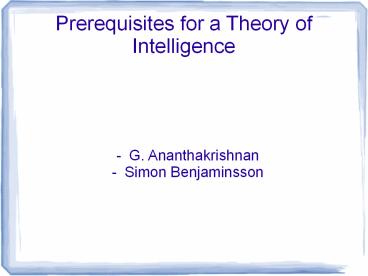Prerequisites for a Theory of Intelligence - PowerPoint PPT Presentation
Title:
Prerequisites for a Theory of Intelligence
Description:
Prerequisites for a Theory of ... Emergence Robot Puppy Slide 11 Articulation- Acoustics Role of Embodiment The Diva System Reference Frames Variance ... – PowerPoint PPT presentation
Number of Views:168
Avg rating:3.0/5.0
Title: Prerequisites for a Theory of Intelligence
1
Prerequisites for a Theory of Intelligence
- - G. Ananthakrishnan
- - Simon Benjaminsson
2
Popper Vs Feyerabend
- Popper
- The Logic of Scientific Discovery
- Theory has temporary status
- Falsifiability of a theory
- Against psuedo-theories like Freudian psychology
etc.
- Feyerabend
- Against Method
- No precise rules
- Anything goes
- Anarchist approach to scientific theory
3
Abstraction, Algorithms, Dynamical Systems etc.
- Abstraction is necessary
- Principles of systems can be predicted, but
specific system needs some empirical values - Can a theory of intelligence be algorithmic?
- Can we have an algorithm which computes and
thereby explains all intelligence? - Dynamic systems chaos theory
- Structured systems emerge from chaotic conditions
- Analytical component Design aspect
4
Diversity (exploitation) - Compliance
- Soft Rules
- Choice about compliance
- Syntax Vs Semantics Grammar Vs Content
- Grammatically incorrect no compliance
- Grammatically correct, but repetitive no
diversity - Hard Rules
- Laws of Physics
- No choice but to comply
- Only possible to exploit
- Rock only complies, does not exploit
5
Exploitation and Knowledge
- Rock flowing down river
- does not exploit, no diversity,
- only complies with fluid dynamics
- Asimo robot that can dance, walk etc.
diversity, exploits friction and gravity - Fish exploits fluid dynamics
- Do they know they are exploiting?
- Humans write poems, exploiting some figures of
speech, possibly breaking some soft rules - Do we know? Do we need to know?
6
Stability-Flexibility (accommodation -
assimilation)
- Category learning
- Representation of the world
- Do we need only one example or several examples?
- Role of the right features?
- Categorizing unknown objects
- Soft categorization
- Exploration-Exploitation
7
Frame-of-reference problem
- An intelligent agent
- Conforms to rules/laws (Hard or Soft)
- Exploits the environment
- Exhibits diverse behavior
- May or may not be aware of this behavior
- Complex behavior with simple rules
- e.g., beach ant walks around puddles, twigs etc.
without knowing what the obstacles are - From ant's perspective simple rules
- From observer's perspective complex behavior
8
Swiss Robots
- The Swiss Robots Demo
- Simple rules
- Unexpected behavior
- Robots do not see cubes
- Intelligent? - Depends on perspective
- Different location of sensors?
9
Interaction - Emergence
- Robot's perspective reaction to sensory
stimulus - Our perspective cleaning up of Styrofoam cubes
- Effect of interaction of internal mechanism with
environment - Behavior cannot be estimated solely by the
internal mechanism embodiment, environment - Emergence of complexity from simple rules and
interaction with environment - What if cubes were heavier, what if sensor was
placed differently, what is the cubes were
slightly larger or slightly smaller?
10
Robot Puppy
- Motor and spring mechanism copies the gait of a
puppy - Uses pressure sensors on the feet to sense the
ground - Hip and shoulders are moved periodically
Theo jansen's kinetic animals
Pressure Sensors
New Species, Ted Talk (2.14 mins)
- The dog sees the world from the view of its
sensors - Complex gait mechanism from simple principles
11
- Over to Simon
12
Articulation- Acoustics
- Motor movement
- Visual representation
- Spatial-to-Motor reference frame
- Invariant (for the same posture)
- Bias for certain arm postures
- Articulator movement
- Acoustic representation
- Invariant? e.g. American /r/
- Highly non-linear
- Frame-of-reference?
13
Role of Embodiment
- Vocal-tract to Sound (Maeda Model)
- Application of fluid dynamics and computation of
tube resonances. - Control of vocal-tract parameters
- Inertia of articulators
- Muscles that control articulation
- Degrees of freedom for articulation
- Planning of articulation
- Targets and paths
- Acoustic/Perceptual features
14
The Diva System
GOF Neural Network
?
Embodiment
Partial Embodiment
15
Reference Frames
- Articulatory
- Degrees of freedom
- Constriction
- Motor equivalence
- One-many mapping with Articulatory frame
- Acoustic/Perceptual
- Formant frequency differences
16
Variance in Constriction
17
Some Equations
18
Solving a specific problem Variation in /r/
19
Explained by DIVA
Resulting configuration of /r/ Bunched
Resulting configuration of /r/ Retroflexed
20
Some videos Other applications of DIVA
Random Babbling
Reduplicated Babbling
21
Some videos Other applications of DIVA
Attempt 3
Attempt 2
Attempt 1
22
Some videos Other applications of DIVA
Simulation of Stuttering (as predicted by DIVA)
23
Thank You
- Any Questions?































